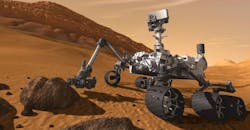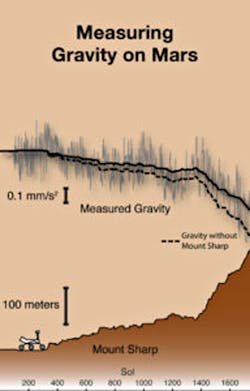Re-Engineering a Martian Rover into a Gravity Sensor
Scientists can learn a lot about a planet by measuring the strength or changes in gravity over an area. Examining variations in gravity lets them calculate the underlying rock’s density and its geological history. This goal motivated a group of researchers at Johns Hopkins University to devise a way to redesign Curiosity, the Martian rover that has been exploring the Gale Crater on Mars for the last six-and-a-half years.
Typically, to measure gravity on Mars and other planets, researchers rely on orbiting satellites such as the Mars Reconnaissance Orbiter. But because satellites are so far away from their targets, the spatial resolution is limited. For example, one can barely make out Gale Crater in the satellite gravity data of Mars, a feature with a 93-mile span.
The research team tried calibrating the rover’s accelerometers to measure surface gravity as the rover climbed Mount Sharp, a three-mile-high mountain within the crater and the main focus of Curiosity’s exploration. The rover’s accelerometers let the robot determine its position and navigation. In fact, Curiosity had already collected hundreds of measurements over much of the mission that the team could use to measure subtle changes in gravitational acceleration.
As Curiosity climbs Mount Sharp, getting farther away from the center of Mars, the planet’s gravitational pull slightly weakens. However, measurements using the rover’s accelerometers (gray) show that gravity is not falling off as fast as expected from its elevation change. The difference between the predicted (dashed black line) and modeled (solid black line) gravity result from the additional downward pull of the mass of Mount Sharp itself, letting researchers estimate the density of the rocks beneath the rover. (Credit: Kevin Lewis)
First, the team accounted for Mars’ rotation to accommodate expected changes in acceleration. Next, it calibrated this raw information, accounting for the effects of temperature, the tilt of the rover, and other factors.
The researchers soon discovered that Curiosity was moving over low-density rock. The CheMin instrument on the rover, which determines the mineralogy of the rock, had previously indicated the sedimentary minerals were not low-density, meaning the sedimentary rock must be highly porous.
When sediments are first deposited, they typically contain lots of empty space. As they get buried deeper and deeper over time, sediments are compressed and their density increases.
Scientists have previously suggested that the Gale Crater may have been completely filled with sedimentary rock and, over time, Mount Sharp was carved out of these layered sediments by erosion. However, the low subsurface density the team found along Curiosity’s path at the base of Mount Sharp implies it was never buried very deeply. This suggests the layers of Mount Sharp never completely filled the crater. One explanation is that the upper layers of the mountain were formed by wind-driven processes rather than in a lake.
Going forward there might be even more coming from the Curiosity and its newest instrument.


